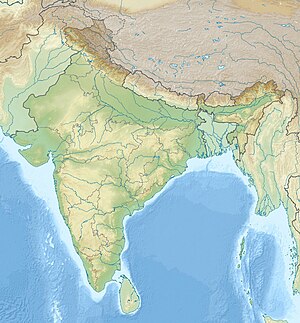Asirgarh Fort
This article needs additional citations for verification. (June 2015) |
| Asirgarh Fort | |
|---|---|
| Part of Madhya Pradesh, | |
| Nepanagar | |
 Asirgarh Fort in 2013 | |
 Asirgarh Fort | |
| Coordinates | 21°28′N 76°17′E / 21.47°N 76.29°E |
| Site information | |
| Owner | Government of India |
| Open to the public | yes |
| Condition | dilapidated |
| Site history | |
| Built by | Asa Ahir, Yadav King |
| Materials | Stone, Limestone and Lead |
| Garrison information | |
| Occupants | Ahirs->Faruqi dynasty->Mughal->Maratha->Holkars->Shinde->British |
Asirgarh Fort is an Indian fortress (qila) situated in the Satpura Range about 20 kilometres (12 mi) north of the city of Burhanpur, in the Indian state of Madhya Pradesh. Because the fortress commands a pass through the Satpuras connecting the valleys of the Narmada and Tapti rivers, one of the most important routes from northern India to the Deccan, it was known as the "key to the Deccan". During the Mughal Era, it was considered that the Deccan started here while the empire from Asirgarh to Delhi was considered Hindustan.
History[]

The Asirgarh fort is said to have been built by a king named Asa Ahir in the early 15th century. He was murdered by Nasir Khan of Khandesh.[1][2]
Nasir Khan's descendant Miran Bahadur Khan (1596–1600) declared his independence and refused to pay homage to the Mughal emperor Akbar and his son Daniyal. Akbar marched towards Burhanpur in 1599 and occupied the city. Akbar then besieged Asirgarh fort and captured it on 17 January 1601.[3]
During the Second Anglo-Maratha War, on 18 October 1803, British forces took the pettah of Asigarh with a loss of two killed and five wounded. The fort's garrison subsequently surrendered on the 21st after the attackers had erected a battery.[4]
Toward the end of the Third Anglo-Maratha War in early 1819, the remaining Maratha forces gathered at Asirgarh Fort under the command of the qiladar, Jeswant Rao Lar. In March, a massive contingent of combined British army regiments lay siege to Asirgarh, attacking and occupying the town associated with the fort. The roughly 1,200-strong Maratha defenders defended the fort against constant artillery barrages and charges of foot soldiers. They finally surrendered to the British on 9 April 1819 with the loss of 43 men compared to the 323 British casualties. The British victory at The Battle of Asirgarh Fort brought an end to the war.[5][6]
Architecture[]
The architecture of the fort was influenced by the Mughals, an amalgamation of Islamic, Persian, Turkish and Indian styles. There are three man made ponds to provide a water supply.
There is a temple known as Gupteshwar Mahadev Mandir, dedicated to the Hindu deity Shiva. There is a local legend that Ashwatthama, a character in the Indian epic Mahābhārata, used to come to this temple to worship and offer flowers each morning to Lord Shiva.
There is a ruined mosque with minarets known as Asir Masjid inside the Fort. Apart from the Hindu and Muslim architecture, some ruins are of British origin and there are also British graves. This fort has been deserted following the departure of the British.
References[]
- ^ B H Mehta. Gonds of the Central Indian Highlands Vol II. Concept. p. 569.
- ^ Numismatic Digest. Numismatic Society of Bombay, Original from the University of Michigan. 2003. p. 141. Retrieved 22 April 2018.
- ^ Sen, Sailendra (2013). A Textbook of Medieval Indian History. Primus. p. 164. ISBN 978-9-38060-734-4.
- ^ Reginald George Burton (1908). Wellington's Campaigns in India. Calcutta : Superintendent Govt. Print., India. pp. 67–68. ISBN 978-0-9796174-6-1.
- ^ Cannon, Richard (1849). Historical Record of the 67th Foot. London: Parker, Furnivall & Parker.
- ^ Burton, R.G. (1910). The Mahratta And Pindari War. Simla: Government Press.
External links[]
| Wikimedia Commons has media related to Asirgarh Fort. |
- Forts in Madhya Pradesh
- Burhanpur district
- Mountain passes of Madhya Pradesh
- Former capital cities in India

